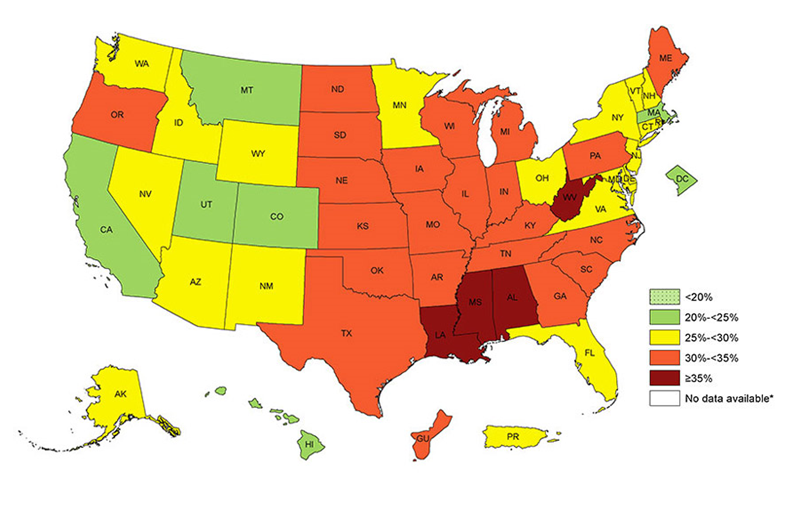
More than one-third of U.S. adults –specifically, 34.9 percent or 78.6 million – are obese, according to the Centers for Disease Control and Prevention (CDC). While obesity is now common, it also poses a serious health and an increasingly costly financial risk to the healthcare industry.
A series of maps that graphically illustrate the trend in age-adjusted prevalence of obesity and diagnosed diabetes among U.S. adults aged 18 years or older from 1994 through 2015 was released April 2017 by CDC. And the picture the maps paint is startling. During the period 1995 to 2015, prevalence of obesity and prevalence of diagnosed diabetes rose in all states, and at an alarming rate.
According to study findings, in 1994 all but two states had prevalence of obesity less than 18 percent and no state exceeded 22 percent. However, in 2015 no state had less than 18 percent and all but one state exceeded 22 percent. Similarly for diagnosed diabetes, in 1994 no state had prevalence less than 6 percent. In 2015, all states exceeded 6 percent; 27 of these exceeded 9 percent.
The data source and methodology used to determine prevalence of obesity and diagnosed diabetes among U.S. adults aged 18 years or older were determined using data from the Behavioral Risk Factor Surveillance System (BRFSS), available on the CDC website at http://www.cdc.gov/brfss. BRFSS provides state-specific information on behavioral risk factors for disease and on preventive health practices via an ongoing, yearly, state-based telephone survey* of the non-institutionalized adult population in each state.
Survey respondents who reported that a physician told them they had diabetes were considered to have diagnosed diabetes, the exception being women who reported being diagnosed with diabetes during pregnancy. Self-reported weight and height were used to calculate body mass index (BMI): weight in kilograms divided by the square of height in meters. BMI greater than or equal to 30 was considered obese. Rates were age-adjusted to the 2000 U.S. standard population based on age groups 18-44, 45-64, 65-74 and 75 years or older.
One main outcome seen by viewing CDC’s Obesity Prevalence Maps is that obesity prevalence in 2015 varies across states and territories. No state had a prevalence of obesity less than 20 percent. In six states – California, Colorado, Hawaii, Massachusetts, Montana and Utah – and District of Columbia, obesity ranged from 20 percent to less than 25 percent. Puerto Rico along with 19 states had a prevalence of obesity between 25 percent and less than 30 percent. Obesity prevalence in 21 states and Guam was 30 percent to less than 35 percent. Four states – Alabama, Louisiana, Mississippi and West Virginia – had obesity prevalence of 35 percent or greater. Regionally, the South had the highest prevalence of obesity at 31.2 percent, followed by the Midwest at 30.7 percent, Northeast at 26.4 percent and West at 25.2 percent.
Demographics reveal non-Hispanic blacks have the highest age-adjusted rates of obesity (48.1 percent) followed by Hispanics (42.5 percent), non-Hispanic whites (34.5 percent) and non-Hispanic Asians (11.7 percent). Obesity was reported to be higher among middle age adults age 40-59 years (40.2 percent) and older adults age 60 and over (37.0 percent) than among younger adults age 20-39 (32.3 percent).
As the obesity rate in the United States continues to rise, so too do associated health risks and related medical costs. CDC says obesity-related conditions include heart disease, stroke, type 2 diabetes and certain types of cancer, some of the leading causes of preventable death. Additionally, the estimated annual medical cost of obesity in the United States was $147 billion in 2008 U.S. dollars. Of note is that medical costs for people who are obese were $1,429 higher than those of normal weight.
CDC says no single or simple solution exists to the obesity epidemic. It is a complex problem that needs a multifaceted approach. As such, CDC encourages policy makers, state and local organizations, business and community leaders, schools, childcare and healthcare professionals, and individuals to work together to create an environment that supports a healthy lifestyle.
That said, CDC notes the key to achieving and to maintaining a healthy weight is not short-term dietary changes; it requires a lifestyle that includes healthy eating and regular physical activity.
*NOTE: Major changes were made in the survey methods in 2011; caution should be taken when comparing estimates across 2011 (please refer to http://www.cdc.gov/surveillancepractice/reports/brfss/brfss.html for more detailed information).
Resources:
- Additional information on overweight and obesity and additional obesity trend data are available at http://www.cdc.gov/nccdphp/dnpa/obesity/index.htm.

